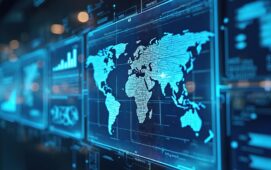
On September 19th, Buy AND Build: The Future of Capital Markets Technology returns to London at the Marriott Hotel, Canary Wharf for its second year. This A-Team Group event offers a timely exploration of how financial institutions and technology providers can collaborate more effectively to modernise trading platforms and drive innovation. As firms increasingly transition from monolithic legacy systems to flexible, component-based architectures, the ability to strategically combine both buying and building technology will be essential for achieving long-term success.
This year’s program features real-world case studies that reveal best practices, key success factors, and the common pitfalls to avoid when implementing new technology across the trading stack. With discussions covering topics from agile data infrastructure and cloud computing to low-code frameworks and microservices, attendees will gain valuable insights into crafting a competitive, future-ready trading platform.The Future of the Trading Desk
The day’s proceedings will commence with a Keynote fireside chat, where Matthew McLoughlin, Chief Commercial Officer & Partner at Liontrust Asset Management, will dive into the key technology and market forces shaping the future of the trading desk, examining how firms can keep their systems aligned with the rapid pace of innovation despite budgetary constraints. Attendees will explore the essential skills and technologies that will define the trading desk of tomorrow, including the transformative potential of AI, its opportunities, and its challenges. The session will also highlight the progress firms are making in harnessing data sources and analytics, and explore strategies for leveraging partnerships and collaborations to accelerate development, build trust, and deliver greater value in an increasingly competitive landscape.
“Investing in scalable and interoperable technology and processes is essential in today’s dynamic trading environment,” says McLoughlin. “As the landscape evolves rapidly, it is imperative to drive innovation by efficiently leveraging data and technology, while also ensuring that your organisation possesses the right skillsets to fully capitalise on these advancements. Strategic collaboration with technology, data, and trading partners plays a critical role in achieving this objective, enabling firms to stay competitive and maximise their potential in an increasingly complex market.”
Component-Based Trading Architectures
The first panel session of the day will explore how firms can transition to a modern, component-based trading architecture by adopting a ‘Buy AND Build’ approach. Panelists will address the limitations and challenges of solely buying or building technology and provide guidance on how firms can determine the right balance between the two when considering new data and technology products. The discussion will also focus on what financial institutions seek in a technology partner and the essential elements for a successful collaboration. Attendees will gain insights into the critical success factors for effective technology integration and learn about the expected benefits and return on investment from this dual strategy. Panelist Mike Gatny, President & COO of Connamara, comments: “As a custom engineering firm, Connamara is in a unique position to understand the factors involved in deciding what to buy or build. In my experience, we find the right balance for our customers by buying to contain project cost and risk while building what differentiates them from their competitors.”
Following the morning networking break, Anvar Karimson of Kepler Cheuvreux and Matt Barrett of Adaptive will present a case study entitled ‘Innovation unleashed! Building a competitive advantage with a flexible and agile high performance trading platform’. The case study will cover critical success factors for fostering successful technology partnerships and provide guidance on building open platforms using deterministic event-driven architectures and cloud technologies. Attendees will gain key insights from real-world lessons learned, and receive practical advice on identifying and measuring the key metrics and return on investment for a new trading platform.
“Modern, modular trading architectures are ushering in the next generation of built solutions that tackle critical challenges faced by traders and give firms the flexibility to adapt to their clients’ changing needs,” says Barrett. “Powerful cloud-based solutions and open-source technologies are fundamentally changing how we develop these trading systems – allowing us to create truly dynamic, future-proof solutions that allow users to navigate fast-moving markets.”
“Deciding what to build vs. buy is never easy, but getting it right empowers you to craft tailored solutions with agility, leveraging advanced algorithms and cutting-edge technologies for your specific needs,” adds Karimson. “Embracing open technologies gives you the flexibility to rapidly iterate, integrate proprietary strategies, and stay ahead in fast-paced markets, ensuring your competitive edge.”
All About the Data
The next panel session, entitled ‘Modernising data infrastructure and creating a strong data foundation for trading applications’, will examine the essential components and capabilities needed for a modern data infrastructure, as well as where firms currently stand on their journey to achieving a unified view of their data landscape. It will explore how new tools and techniques—such as cloud, data fabric or mesh, knowledge graphs, glossaries, and catalogs—are being utilised to integrate and unify disparate data sources. Attendees will also learn about best practices for data ingestion into cloud environments and discuss strategies to mitigate cloud concentration risks and enhance operational resilience in light of increasing regulatory scrutiny, such as under the Digital Operational Resilience Act (DORA).
James Munro, Head of ArcticDB at Man Group, will then present a case study on enabling data science and analytics with intuitive data storage and retrieval. This case study will explore the challenges involved in building data tools for quantitative analysis, focusing on how various design and implementation factors influence the choice of tools. Munro will discuss the reasons why an asset manager might choose to develop their own solution rather than relying on off-the-shelf products, and share key lessons learned throughout this process. The presentation will also reflect on the decision-making behind the build versus buy approach and evaluate the satisfaction with those choices.
“Ultimately data productivity is the direct driver of improving trading skill, it’s vital you find the right tools and deploy them with urgency,” says Munro. “Quants are competing to extract the most value out of data before everyone else, for that you need to find the right tools, the right people and the right data.”
Low Code No Code
The afternoon sessions will commence with a panel looking at the practicalities of implementing interoperability and low code no code (LCNC) development frameworks, which will cover key considerations for deciding whether to buy or build these technologies and provide practical guidance on how to begin an interoperability or LCNC implementation. Participants will learn about the common standards required to achieve effective interoperability, discover best practices for managing projects that utilise these technologies, and examine the types of solutions currently being developed with interoperability and LCNC frameworks.
“Interoperability and low code no code frameworks are two technologies that are continuing to trend in terms of what they can do to accelerate innovation and modernisation in financial services,” comments panel moderator Reena Raichura, Founder at Finergise. “The great thing is that the two technologies are completely complimentary. They are two halves that make a whole when it comes to modernising legacy platforms and building a future-proof best-of-breed interoperable technology stack.”
Industry Case Studies
Two industry case studies will follow. The first, ‘Strategic ETF workflow modernisation at speed and scale’, presented by Jon Butler of Velox and Jeffrey Baccash of BNP Paribas Securities Services, will address the workflow challenges impacting user and developer productivity within the exchange traded fund (ETF) trading space, and how firms can strike the right balance between buying and building solutions to modernise their workflows quickly and at scale. Attendees will hear lessons learned from a successful collaborative partnership that has rapidly delivered live products, and discover the benefits of a streamlined workflow, along with specialised tools and functionalities that support continuous evolution in this dynamic market. “‘Buy and Build’ is traditionally associated with large standalone projects like new trading systems. However, in our session, we will show how BNP successfully applied a buy and build approach to an internal workflow problem that spans multiple systems and internal departments,” says Butler. “The project is creating operational efficiencies in ETF’s, one of the fastest growing asset classes, and upgrading the ETF primary market experience for BNP’s clients and authorised participants.”
The second, ‘Transforming the equity trader’s workflow with Interoperability’, presented by Dan Schleifer of Interop.io and Dan Green of T. Rowe Price, will guide attendees through the journey of a successful interoperability project, from initial ideation to full-scale production. It will explore key principles to consider, such as customisation and scalability, and outline the essential steps for delivering a working prototype. The discussion will also cover strategies for securing internal buy-in and encouraging traders to adopt the new platform, highlighting specific workflows that T. Rowe Price has developed to enhance trading efficiency and effectiveness. “Interoperability is becoming a core piece of architecture to streamline and simplify the way firms build and maintain technology,” says Schleifer. “T. Rowe Price is a great example of how interoperability can benefit these teams and their clients.”
Integrating AI & ML
The final panel session of the day will explore how firms can leverage alternative data sources and advanced AI and machine learning techniques, including generative AI and large language models (LLMs), to gain deeper insights in trading analytics and research. Attendees will learn about the critical success factors for effectively integrating AI and ML tools into trading workflows, and whether firms should build or buy their AI expertise. The session will also provide insights into the future of strategic investment in AI and how analytics will continue to shape and improve the trader’s evolving workflow.
“AI and machine learning have huge potential to improve trading, from better analytics to improved research and decision making,” says panelist Dr. Elliot Banks, Chief Product Officer at BMLL. “As with any new technology, however, potential is not enough, and a firm’s ability to leverage AI will be determined by how well it can actually be integrated and deployed into production workflows. An essential aspect of AI is training models (teaching AI models to perform tasks by feeding them data and algorithms). To do this well, you need access to the highest quality historical market data. In this panel, we’ll discuss how to leverage historical market data and analytics to achieve successful integration of AI.”
After the sessions, delegates will have the chance to connect and network with their peers over drinks. As space is limited, we encourage early registration to secure your spot. Or register below.
Subscribe to our newsletter




